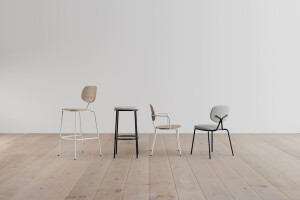This sofa is made by rolling and bending of thin plastic sheets finished with fabric skin.
The form of the sofa resembles a combination of cartoon characters, ribbons, Japanese Kimono, and European Baroque hairstyles. While the raw material of the sofa is entirely based on flat sheets of various 2 dimensional shapes, the sofa as the final product is a multifaceted, 3 dimensionally complex object. The impression of the sofa changes as one walks around it. Views of the sofa from the back, sides and angles are equally as important as the frontal image.
This sofa is made by bending 2.4 mm thick plastic sheets in such ways that they become structurally stable by the density of its rolling effects. 2mm thick felt sheets are adhered to each side of plastic sheets, providing a comfortable surface. Where each plastic sheet meets, they are stapled with metal rods, behaving like a woven fabric. When a person sits, the sofa deforms slightly, feeling like a soft cushion.
While it might at first appear to be a sofa with a focus more on aesthetics than on function, a closer observation reveals that the structural system itself is the aesthetics of this sofa. Every parts of this sofa are structurally necessary to become a cohesive final product, leaving no parts simply just as ornaments. This sofa is devoid of a conventional material content such as foam inside a typical sofa. While material substance is minimized, a concept itself becomes the substance of this sofa. A conceptual design approach is synthesized with the economy of material production.
In order to make a shipping of this sofa economical, it can be shipped unassembled. Armrests, seating, and backrest of the sofa can be separated and each part can be packed in smaller boxes.
For this particular version, 2 mm felt sheets in red color are used as the finish texture adhered to both sides of plastic sheets. However, other finish fabric material of various designs can also be used instead.
The naming of this sofa is designed in similar ways as in the design of the chair itself. Various, often conflicting ideas are synthesized into one thing that is the hybrid of these ideas. First of all, this sofa resembles a ribbon. Secondly, this sofa is a “re”-interpretation of a conventional idea of a sofa in terms of its form as well as in terms of its design process. Process becomes the product. Process is based on repetitive acts of bending and rolling of thin plastic sheets. “Re bon bon” is neither a noun nor a verb --- it is this sofa itself.
















